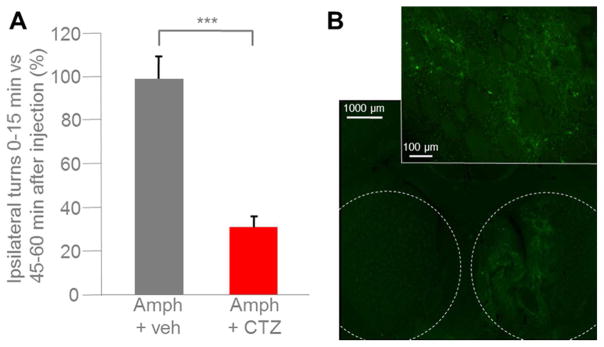Figure 8.
Amphetamine-induced rotational behavior attenuated by LMO4. Adult male rats (n = 3) were injected with 6-OHDA into the right hemisphere with coordinates set to target the medial forebrain bundle. AAV-hSyn-LMO4 was injected into the right striatum. A lateral ventricle cannula was implanted into the left hemisphere. For testing rotational behavior rats were injected intraperitoneally with amphetamine (2.5 mg/kg), and ipsilateral rotations were counted for the first and last 15 min of an hour. A: The same three animals were tested with vehicle injection (Amph + veh) and with CTZ injection at the time of amphetamine application (Amph + CTZ; final concentration of 200 μM in CSF). Bars indicate mean percent of amphetamine-induced ipsilateral rotations during the first 15 min of testing. Data are normalized relative to number of turns during the last 15 min (between 45 to 60 min after amphetamine injection). CTZ, but not vehicle, decreases the number of ipsilateral rotations significantly for the first 15 min after injection (P = 0.002017). B: Fluorescence images of a coronal section from a rat at the end of the experiment. Stippled lines in overview image (5x) mark right and left striatum; higher magnification image (20x) zooms in on right striatum. Neurons expressing LMO4 show green fluorescence from the EYFP reporter.

